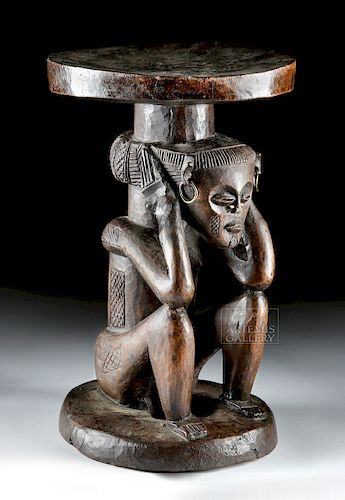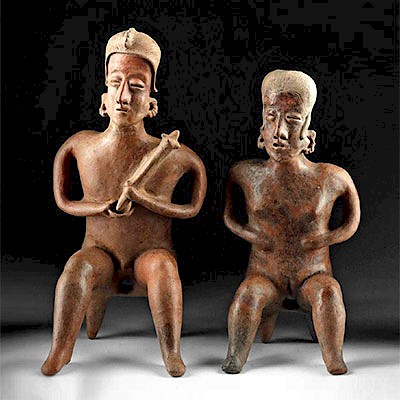Important 19th C. Chokwe Wood Stool, ex-Sotheby's
Lot 156e
About Seller
Artemis Fine Arts
686 S Taylor Ave, Ste 106
Louisville, CO 80027
United States
Selling antiquities, ancient and ethnographic art online since 1993, Artemis Gallery specializes in Classical Antiquities (Egyptian, Greek, Roman, Near Eastern), Asian, Pre-Columbian, African / Tribal / Oceanographic art. Our extensive inventory includes pottery, stone, metal, wood, glass and textil...Read more
Estimate:
$15,000 - $25,000
Absentee vs Live bid
Two ways to bid:
- Leave a max absentee bid and the platform will bid on your behalf up to your maximum bid during the live auction.
- Bid live during the auction and your bids will be submitted real-time to the auctioneer.
Bid Increments
| Price | Bid Increment |
|---|---|
| $0 | $25 |
| $300 | $50 |
| $1,000 | $100 |
| $2,000 | $250 |
| $5,000 | $500 |
| $10,000 | $1,000 |
| $20,000 | $2,500 |
| $50,000 | $5,000 |
| $100,000 | $10,000 |
| $200,000 | $20,000 |
About Auction
By Artemis Fine Arts
May 23, 2019
Set Reminder
2019-05-23 10:00:00
2019-05-23 10:00:00
America/New_York
Bidsquare
Bidsquare : Exceptional Day 2 Ethnographic Tribal Fossils
https://www.bidsquare.com/auctions/artemis-gallery/exceptional-day-2-ethnographic-tribal-fossils-4136
Day 2 of an important 2-day auction featuring exceptional ethnographic art from around the world. Today's sale will feature Pre-Columbian from the ancient americas, Native American, African / Tribal, Oceanic, Spanish Colonial, and incredible Fossils. Artemis Fine Arts info@artemisgallery.com
Day 2 of an important 2-day auction featuring exceptional ethnographic art from around the world. Today's sale will feature Pre-Columbian from the ancient americas, Native American, African / Tribal, Oceanic, Spanish Colonial, and incredible Fossils. Artemis Fine Arts info@artemisgallery.com
- Lot Description
Central Africa, Angola or the Democratic Republic of the Congo, Chokwe peoples, ca. late 19th century CE. A rare, well-preserved wooden stool featuring a ring-shaped base, a slightly indented seat, and a seated female figure who crouches against the base and holds the seat on the top of her head. The figure is a nude woman with exposed genitalia and breasts. Cross-hatched, herring-boned, linear, and diamond-pattern motifs wrap around her legs, shoulders, torso, and face, signifying ritual scarification. Brass rings and a thin piece of wood through her septum give her ornament. Her face has deeply incised, almond-shaped eyes narrowed to a slit, each set within a deep ring on the face; a small nose; and a thick-lipped, raised mouth. Size: 8.25" W x 13.5" H (21 cm x 34.3 cm)
The Chokwe Kingdom rose to power in the late 19th century due to lucrative trade with Portugal in rubber, wax, and ivory. Monarchs and other leaders sat in decorated stools like this one, part of a practice of enthronement amongst many Sub-Saharan groups. The figures who adorn Chokwe stools are often called "caryatids", channeling the elegant carvings of women in Greek architecture. The woman on this stool, however, serves a very different purpose to the Greek ladies: she represents a departed ancestor, who provides guidance and protection. Here, she holds her head in sorrow, worrying that her descendants are not honoring her as they should. Her position underneath the seat shows that she symbolically supports the person seated upon it.
See a similar example at the Metropolitan Museum of Art: https://www.metmuseum.org/art/collection/search/311006
Provenance: ex-Sotheby's, New York "Tribal Art" auction (sale 6368, November 24, 1992, lot 145)
All items legal to buy/sell under U.S. Statute covering cultural patrimony Code 2600, CHAPTER 14, and are guaranteed to be as described or your money back.
A Certificate of Authenticity will accompany all winning bids.
We ship worldwide and handle all shipping in-house for your convenience.
#142403Seat has an old repair consisting of a metal strip nailed in place over a crack in the wood. Small signs of wear on the rest of the surface commensurate with age, including very light scratching. Deep, rich patina on surface.Condition
- Shipping Info
-
All shipping is handled in-house for your convenience. Your invoice from Artemis Gallery will include shipping calculation instructions. If in doubt, please inquire BEFORE bidding for estimated shipping costs for individual items.
-
- Buyer's Premium



 EUR
EUR CAD
CAD AUD
AUD GBP
GBP MXN
MXN HKD
HKD CNY
CNY MYR
MYR SEK
SEK SGD
SGD CHF
CHF THB
THB
















